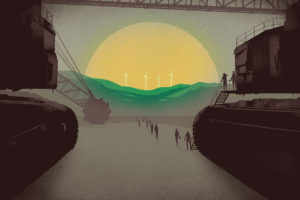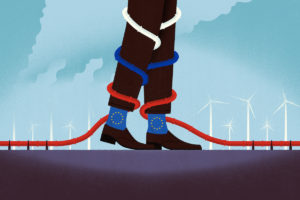Experts are increasingly certain that policies to tackle climate change must be accompanied by a socially just transition if they are to be effective and publicly accepted. But what exactly is such a transition and how might it be achieved?
I spoke with Dr Hanna Brauers, a postdoctoral researcher at Europa-Universität Flensburg in Germany. Brauers is a co-author on a recent report exploring two periods of structural change and associated policies in German coal regions. The first concerned the gradual loss of competitiveness of the western Ruhr area’s hard coal mining industry, between the 1950s and 2010s. The second was a more recent lignite mining phase-down in Lusatia, eastern Germany, driven by disruptive change after Germany’s reunification in 1990.


Brauers’ analysis is not just important for Germany, which plans to phase out coal by 2030, but for other countries in Europe and elsewhere that must also shift their economies away from coal in the coming years. The analysis has several lessons that might inform and inspire policymaking to help coal regions transition.
Our conversation has been lightly edited for length and clarity.
Alice Bomboy: The two phase-outs you explored with your team were very different. Why was it important to look into the past?
Hanna Brauers: We investigated the past but our main motivation was to look into the future. We are now all aware that climate change is happening. That means we need to handle rather quickly many phase-out processes, in all sectors, which contribute to global warming. How can we do it? We have faced and solved so many of these challenges in the past already, so why not be inspired by these two case studies? The phase-out of hard coal mining in the Ruhr area is of great interest because it was handled comparatively well: the German and regional governments got heavily involved with packages of different policies over time. Officials wanted to manage it in a socially just way, and we could see it as an example of a just transition process. In Germany, it is often called “managing structural change” rather than “just transition” but the two phrases mean very similar things.

How can we apply the lessons from these past transitions to the challenge we’re facing now with climate change?
Of course, climate change issues didn’t play a big role in the coal mining phase-out examples that we looked at. In the Ruhr area, the decline of coal started in 1957. Climate change was in people’s minds at the end of this process, as the last hard coal mine closed more than 60 years later in 2018, but it was definitely not a driver when it began. What mattered to us was to bring to light the paths to a socially fair transition and to see how we could adapt those paths to our current situation. In other projects, we looked at what happened in other countries, like the UK, which also implemented a coal mining phase-out: they had fewer accompanying social policies and the resulting social hardships there were a lot worse and continue to this day. It was very important to us to make comparisons between different areas and see what had an impact, and what kind of impacts, and how we can draw conclusions from these experiences and build better structural changes for the future. However, a key point is that many policies were meant to slow down the decline of coal, instead of accelerating it. We cannot afford that now, given the climate emergency.



What are the main lessons learned from these past coal phase-outs?
We saw that these processes shifted over time. At the beginning, policy programmes were mainly focusing on protecting jobs and the coal and steel industries. But they gradually began to switch to something rather different: creating new industries and job opportunities for these regions, as well as a focus on improving quality of life more generally. From building more infrastructure, more roads and railways to connect the cities and industry in the area, they later started investing in research, universities, in training the workforce in new skills, and creating clusters and connections between academia and industry. Policies also focused on cultural and recreational activities, as well as mine restoration. Policy programmes moved from reactive approaches to forward-looking policies, and the idea emerged that to be a better-off region, you had to use your past but couldn’t only cling to it: you had to build something new and more diverse. Also, it becomes apparent now, that if you just switch from being dependent on the coal industry to another single-industry sector, the same challenges are likely to re-emerge sooner or later.


Does the current profound reorganisation of the energy sector, happening now in several European countries, reinforce the need for a former coal area to diversify its activities?
Transitioning coal regions can of course use part of their assets, knowledge and capacities in the energy sector. But we are clearly moving, at least in Germany, from a super-centralised fossil fuel infrastructure based in a few regions to renewable energy infrastructures that are more decentralised. A former coal area could use its expertise in energy and specialise in the manufacture of wind turbine blades for instance, but it’s just not going to be the same scale as the coal industry was. It is important to diversify into other fields and not just rely on past expertise in energy.
Your report emphasises the importance of transparency during a transition, and the need to explain that transition processes are not always straightforward and that negative aspects cannot always be compensated.
This is indeed what we developed in the report. But my personal point of view has evolved on this aspect, and I now fear that if you communicate too much about the uncertainties and the hardship carried by a transition process, people might be discouraged and reluctant to join and support it. This is a discussion we often have about climate change. Look at the IPCC conclusions: they clearly indicate that we need to change our lifestyle, that this very needed transition will have large consequences on our way of life and that those can’t always be compensated in one way or another. Do people feel ready for that? Not really. The same discussions are happening now about the war in Ukraine: most of us say we want to end this invasion, but Germany is not really willing to pay the price of ending Russian gas imports, for example. I won’t talk much about the pandemic but it clearly shows how people are not good at handling uncertainties.

I’d now say that a more effective communication approach would be to enlighten people on what is being implemented, which new opportunities are being created along the transition process: when a region phases out coal, life improves in terms of air and water quality, and it can also move from a male-dominated industry that is harmful to human health and the climate, to a more inclusive, gender equal and safer labour market, while still ensuring well-paid jobs.
What are the challenges to better involving stakeholders in such transition processes?
The participation of diverse stakeholders is a key point for a successful process. In Germany, this has been organised repeatedly with commissions, including different representatives such as the industry, unions and citizens from impacted villages. These local representatives were included in the phase-out decision-making process, and also in suggesting new projects in the regions that can receive funding. However, this involvement should always be paired with high-level strategic thinking about the direction a region could move in. Otherwise, there’s a high risk that these local initiatives will focus on what they know already and might reproduce past schemes, unfit for the changes to our economies due to the climate crisis and other challenges that we can already foresee.
What advice would you give to other regions committed to phasing out coal, whether in Europe or elsewhere in the world, such as China?
Mainly to be quick and to act holistically. Climate change requires us to change rapidly. Staying behind and waiting until you have no choice but to change is a very bad option. The situation in Europe regarding Russian gas is a perfect example: the countries that haven’t already taken the steps to get rid of their dependency are experiencing a much harder dilemma now and it will cost them more money and will have bigger impacts on them. In terms of energy, and more broadly in terms of climate, planning ahead definitely makes sense if it’s paired with quick actions. From a policymaker’s perspective, ensuring people don’t get stuck in their fear that everything is going to be worse – because it doesn’t have to be – can make the process a lot easier. One last important point would be not to focus the diversification on centralised, male-dominated industries, but to create a future where everybody, men and women, have meaningful and well-paid jobs. This could open many more opportunities to everyone, not just the mining and heavy industries, and in the end create a more resilient society.

The full report, “Structural change in coal regions as a process of economic and social-ecological transformation,” can be read here.






